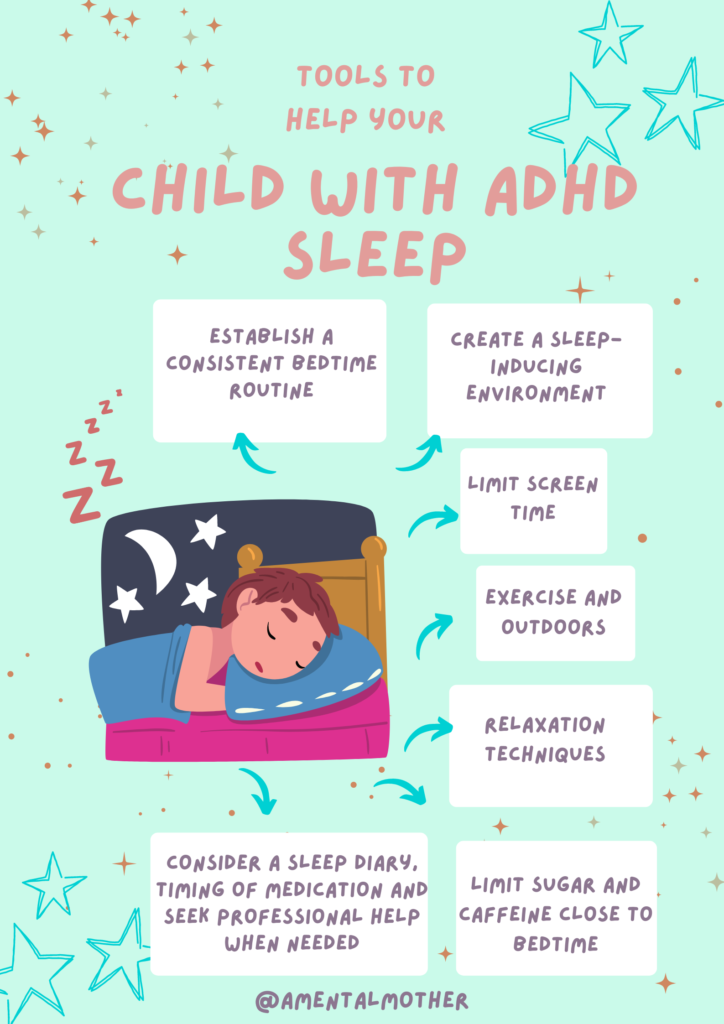As both a pediatric psychiatric mental health nurse practitioner and a mom, I’ve been in the trenches of bedtime battles with children who have ADHD. Kids with ADHD can find it tough to unwind, relax, and drift off to dreamland. This nightly challenge can drain the whole family, turning bedtime into a dreaded event. But here’s the good news: armed with a bit of know-how and a lot of empathy, transforming bedtime from a battleground to a peaceful retreat is totally doable. This guide isn’t just advice; it’s a toolkit for peaceful nights, backed by science and tested by families like yours, helping children achieve a better night’s sleep.

Understanding the Sleep-ADHD Connection in Children with ADHD
ADHD (Attention Deficit Hyperactivity Disorder) is a neurodevelopmental disorder characterized by inattention, hyperactivity, and impulsivity. These symptoms don’t clock out at bedtime. In fact, they can make the process of falling and staying asleep more complicated. Children with ADHD often face a trio of sleep foes: difficulty falling asleep, staying asleep, and achieving deep, restorative sleep.
ADHD symptoms can significantly impact a child’s sleep, leading to moderate to severe sleep difficulties and other medical sleep problems like obstructive sleep apnea and restless legs syndrome.
The reasons behind these sleep challenges can vary but often include:
Hyperarousal: ADHD brains tend to remain in a state of alertness, making it hard to relax.
Medication side effects: Stimulant medications, commonly used to manage ADHD symptoms, can interfere with sleep.
Inconsistent sleep routines: Without a regular and calming bedtime routine, children’s sleep issues can be exacerbated.
A Toolbox for Tranquil Nights
Addressing the sleep challenges associated with ADHD involves a holistic approach. By combining solid sleep hygiene practices, behavioral strategies, and, when necessary, medical interventions, we can guide our children towards more restful nights. Below are strategies rooted in scientific research and clinical practice, designed to promote better sleep for your ADHD child. For persistent sleep issues, it is important to consult a child’s doctor.
1. Establish a Consistent Bedtime Routine for Better Sleep
Child’s bedtime is comforting for children with ADHD. A predictable series of steps leading up to bedtime can help signal to their body and mind that it’s time to wind down. Your routine might include:
A warm bath or shower
Brushing teeth
Reading a book together
Gentle stretches or yoga
2. Create a Sleep-Inducing Environment
The bedroom should be a sanctuary that promotes sleep. Consider these adjustments:
Reduce Stimuli: Keep toys and electronics out of the bedroom. The presence of these items can be too stimulating and distracting. Reducing stimuli can help minimize sleep disturbances, especially in children with ADHD. Consider a white noise machine to minimize background noise.
Use Soothing Colors: Opt for calming colors for walls and bedding. Bright colors can be too stimulating.
Control the Temperature: A cooler room is more conducive to sleep. Aim for a temperature between 60-67 degrees Fahrenheit.
3. Limit Screen Time
Screens emit blue light, which can interfere with the body’s natural sleep-wake cycle. Blue light exposure, especially before bedtime, can contribute to difficulty sleeping. Establish a rule to turn off all screens at least one hour before bedtime. Instead, encourage calming activities that don’t involve screens.
4. Exercise and Outdoor Play
Regular physical activity can help manage ADHD symptoms and promote better sleep. Additionally, regular physical activity can help regulate a child’s sleep schedule. Aim for at least an hour of play and exercise each day, but avoid stimulating activities close to bedtime. Any kind of exercise is great, but getting exercise outdoors is even better. The fresh air and sunlight are impactful in regulating sleep-wake cycles and promoting restorative sleep.
5. Address Dietary Factors
What and when your child eats can influence their sleep. Consider these tips:
Avoid caffeine and sugar close to bedtime. Remember, chocolate contains caffeine.
Ensure your child has a balanced diet throughout the day.
A light snack before bed can prevent hunger from waking them up at night.
Additionally, stimulant medication can affect sleep in children with ADHD, similar to how caffeine affects adults. It may lead to challenging behaviors at night as it wears off, so it should be considered when addressing dietary factors.
6. Explore Relaxation Techniques
Teach your child relaxation techniques that they can use to calm down and fall asleep before bed, such as:
Deep breathing exercises
Progressive muscle relaxation. This is a fun Monster Meditation” target=”_blank” rel=”noopener” title=”book”>book
for young kids to get you started
Visualization or guided imagery